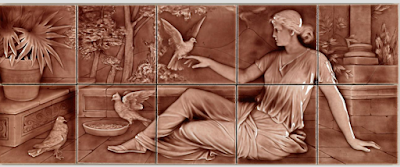image via elliman.com
The Commercial Register, May 1, 1862 (copyright expired)
In March 1866, Hustace signed an agreement with the Brooklyn Flint Glass Works to buy the building for $45,200--about $760,000 in today's money. That sizable debt, coupled with bad luck would have dramatic consequences later that year.
According to authors Davis Dyer and Daniel Gross in their 2001 book The Generations of Corning, "...the Brooklyn Flint Glass Works teetered on the brink. In the fall of 1866, a Dun's correspondent reported that the company 'is in a bad way.'" The firm's troubles were compounded when, on December 3 that year, fire destroyed the Hudson Street building.
It is unclear whether William Hustace had already foreclosed on his property, but it was he who immediately rebuilt. Because the roof was already on in January 1867, it appears that much of the gutted structure was salvaged. Completed that year, the five-story, Italianate style building was faced in red brick above the cast iron storefront. The windows sat upon stone cornices and continuous moldings linked the segmentally-arched openings. The terminal cornice was upheld by unexpectedly understated brackets, only two of which survive.
The Brooklyn Flint Glass Works got back on its feet and later in 1867 announced:
The subscribers would respectfully inform you that their WORKS having been rebuilt and greatly enlarged, they are now prepared with increased facilities to furnish all kinds of Rich Cut, Plain Blown, and Pressed Glassware.
With a new building and much better luck, the firm quickly expanded and in 1868 moved to Corning, New York, changing its name to the Corning Glass Works.
Small manufactories took space in the building, while Michael Foley ran a grocery business from the ground floor store space. The threat of fire plagued William Hustace's building. At 4:30 on the morning of March 13, 1872 fire broke out in the tin can factory of Brown, Cole & Co. It was extinguished before extensive damage was done. Then, four months later on July 26, another fire "from an unknown cause" occurred in Michael Foley's grocery store. Oddly, The New York Times reported it had originated in a window. "Mr. Foley's stock was damaged to the extent of $2,000," said the article. The loss would equal nearly $44,000 today.
The "Cole" in Brown, Cole & Co. was Jonah R. Cole, who was apparently the inventive end of the business. In 1874 he received two awards from the American Institute, one for his "portable cooking apparatus," and the other for a "strainer cover for pots and kettles."
The other tenants at the time were W. D. & A. S. Nicols, makers of "marble, slate and wood mantels" and cast iron "cresting, stable fixtures, fence, grates, weather vanes, &c;" and Ludgren & Frier, manufacturers of "general house-furnishing tinware." The firm made "large and butter pails and boxes for home and shipping purposes."
In May 1880 the Ohio-based American Encaustic Tiling Company announced it had moved into 73 Hudson Street. The colorful architectural tiles it made were vivid and durable, since the colors were not the result of glazes, but of tinted clay. Encaustic tiles were widely used for flooring, fireplace surrounds, and even wainscoting.
The American Encaustic Tiling Company produced these shallow relief wall tiles around 1885. from the collection of the Minneapolis Museum of Art
Troubles between the partners resulted in W. D. & A. S. Nichols going their separate ways. On October 28, 1882 the Real Estate Record & Guide announced that the business, "will hereafter be carried on by Adelbert S. Nichols," adding, "This concern has a reputation second to none in the trade." The firm remained at 73 Hudson Street for another four years, moving to 15 West 27th Street in April 1886."
Brown, Cole & Co. was still operating from the building at the time and Jonah B. Cole was still inventing. In its July 3 issue that year Scientific American reported that he had patented a new folding box. The bottom and sides were made of a single piece, and the corners contained eyelets for a drawstring, "so that by drawing up the ends of the string, the box may be drawn to folded position and so tied."
By the 1890's the neighborhood had become the center of the butter, eggs and cheese district. In 1894 Kemp, Day & Co., a canned food business, occupied space at 73 Hudson Street. In 1894 it employed a force of 35 men, 2 boys, and five women, who worked a grueling 54-hour work week plus nine hours on Saturdays.
The building continued to house dairy firms and by 1955 Dorman & Co., Inc, a member of the Cheese Importers Association of America was here. It would remain at least through 1971.
The Tribeca renaissance arrived at 73 Hudson Street in 1995. On July 2 that year The New York Times reported, "New Yorkers will soon be able to buy 800 types of exotic farm-raised game like ostrich and kangaroo, along with the more common deer and pheasant, at a retail store, Polarica, scheduled to open in the fall."
The turn of the century saw Xiaoping Design in the space. The New York Times columnist Elaine Louie said on September 2000 that proprietor Xiaoping Cao "sells antiques and her own interpretations of Chinese furniture."
Although there has never been a Certificate of Occupancy issued, there are two residential units in the building today, along with three commercial spaces. And, although the much of the cast iron Corinthian capitals of the storefront are gone, and three of the cornice brackets are missing, the handsome 1867 structure is beautifully intact.
no permission to reuse the content of this blog has been granted to LaptrinhX.com






.png)
No comments:
Post a Comment